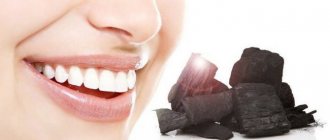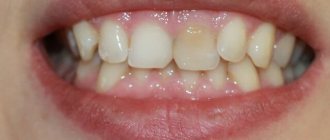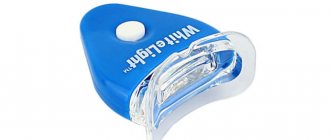Metal-ceramic crown
Modern materials used to make crowns are extremely durable and resistant to dyes. They are quite smooth and non-porous, so pigments cannot penetrate their structure. This is what allows you to limit yourself to daily oral hygiene using a toothbrush and regular paste.
If the material does darken, it is unlikely to be bleached. Metal-ceramics is a very hard and dense material in its structure; none of the modern brightening agents is able to penetrate inside it. In this case, it is possible to talk only about slight lightening, but not about whitening by several tones.
If the crowns are located on the side of the chewing teeth, then nothing will hinder the whitening of the smile area. Moreover, even a strong difference in shades will not affect the patient’s appearance in any way, because others simply will not notice it.
Is it possible to whiten teeth at home?
To maintain the natural whiteness of your teeth, it is important to brush them twice a day with a properly selected brush and toothpaste, rinse your mouth after every meal, use floss and antibacterial rinses, give up cigarettes and coffee, and undergo a professional procedure. hygiene every six months.
But if you naturally have a slightly yellowish or grayish tint to your enamel, even following all of the above measures will not be able to ensure an impeccably white smile. To do this you will have to resort to bleaching. This can be done at home in several ways:
- pencil - brightening gel is produced in a special tube, at the end of which there is usually a soft brush, brush or sponge for convenient application of the composition to the enamel surface. You must use the whitening pencil strictly according to the instructions. Typically, the gel is applied twice in the morning and evening for 2 weeks.
- strips and aligners - the gel can be immediately applied to the strips, which should be glued to the outside of the teeth for a certain time. Other systems include special mouth guards. Their inner surface must be independently coated with a lightening composition and then put on the dentition,
- abrasive pastes - they usually contain coarse abrasive particles, due to which the whitening effect is achieved. However, you cannot use them on an ongoing basis, otherwise you can damage the enamel, which will lead to its weakening and increased sensitivity - the development of hyperesthesia.
When whitening at home, a tray with a special gel is often used.
Before trying any of the methods described above, you should definitely consult a doctor. The specialist will conduct a visual inspection and determine the current condition of the enamel, and give his recommendations on choosing the appropriate system. If the enamel is weakened, thinned or too sensitive, the use of whitening strips and abrasive pastes is strictly contraindicated.
Ultrasonic cleaning of the oral cavity and results
You can lighten artificial dentures a little and restore the attractiveness of your smile with the help of professional cleaning. The whole point of this method is to eliminate plaque, tartar, food particles and deposits that have accumulated on the surface. Currently, specialists use a variety of methods for processing enamel; ultrasonic scalers are in great demand.
This method involves the use of a special device through the tip of which ultrasound and microvibrations are applied. They are capable of destroying even the hardest plaque in just a few seconds without much effort. Simultaneously with ultrasound, the device delivers a stream of water, due to which the enamel is protected from overheating, and crushed particles of contaminants are washed out from its surface.
Dental clinic specialists strongly recommend cleaning your mouth at least once every six months; this will protect the enamel from the accumulation of hard stone and preserve the health of your teeth for a long time. However, this procedure is also ineffective in whitening fillings and crowns.
Care instructions
Despite the fact that metal-ceramic teeth do not require special care, they must be cleaned daily and thoroughly, this is the only way to be sure of a long service life of the prosthesis without unpleasant surprises. Simple but effective recommendations for caring for dentures:
- crowns must be cleaned using vertical sweeping movements from the gums to the cutting edge,
- choose a brush with soft bristles so as not to injure the mucous membrane. It is recommended to use an irrigator.
- if most of the series are dentures, give preference to toothpastes with plant extracts that care for gums,
- be sure to use dental floss to clean the interdental spaces where a lot of plaque accumulates,
- It is advisable to use disinfectant rinses,
- Smokers and coffee lovers should definitely have their teeth professionally cleaned by a dentist, as nicotine and caffeine leave a permanent plaque on teeth and crowns. Whitening pastes will not affect crowns in any way; you should not purchase them.
If possible, buy an irrigator. This is a special device that creates a thin stream of water under high pressure, washing away plaque and food debris from the most inaccessible areas. The irrigator also provides effective massage of the gums, cleanses the tongue and mucous membranes.
Installation of veneers and lumineers
As mentioned earlier, ceramic and plastic crowns are practically not amenable to any of the modern methods of whitening; they can only be cleaned of dirt accumulated on the surface. That is why many patients prefer using more advanced methods of dental restoration, for example, installing veneers.
Veneers are invisible overlays on the frontal area of the teeth, which are fixed using a special dental glue. With their help, you can easily disguise small chips, cracks, darkening of the enamel, as well as slight curvature and even gaps between teeth. These linings are made from very durable and resistant to external influences materials.
An even more reliable and aesthetically attractive option is lumineers. These are exactly the same pads, but thinner. Thanks to this, pre-grinding of the units is not required. Each of these prosthetic options involves taking impressions of the jaw, on the basis of which the onlays themselves are subsequently made. Quite often, doctors prefer to install veneers directly, that is, using a composite material and directly in the patient’s mouth.
Other whitening techniques using restorations
- Veneers
are overlays made of ceramic, porcelain or composite materials up to 1.5 millimeters thick that replace the outer layer of teeth. Unlike lumineers, they allow you to change the shape of your teeth, hide chipped enamel and even correct minor bite defects, but require preliminary grinding of the enamel. - Ultraneers
are medium-thick plates (thinner than veneers, but thicker than lumineers) up to 0.5 millimeters. Used to restore aesthetics and correct enamel defects. Unlike lumineers, which are placed on at least 8 teeth in a row, they are suitable for local elimination of defects. - Componeers
are a new class of plates that are made from a nanohybrid composite. This restoration method provides high aesthetics and durability, but also requires preliminary grinding of the enamel.
Prevention
To ensure that fillings and crowns do not change their color or lose their attractiveness over time, it is very important to properly care for them. Care involves daily oral hygiene (morning, evening, and after each meal). It is also very important to remember to visit your dentist regularly for checkups.
In addition to the timely detection of enamel and gum diseases, the doctor can carry out preventive cleaning. If a patient has a bridge installed in their mouth, they should rinse the area between the crown and the gum tissue as often as possible. In this case, you can use a device such as an irrigator.
Other recommendations include abstaining from eating solid and coloring foods, strong coffee and black tea, red wine, quitting smoking and other bad habits. It is important to avoid strong temperature changes, as this can lead to loosening of the material and its darkening in the future.
previous post
Is it possible to treat teeth with stomatitis?
next entry
Reasons for discoloration of prosthetic structures
Immediately after installation, dentures look attractive, but over time their aesthetics often decrease. The reason for this may be poor quality materials. If acrylic or nylon with an insufficiently dense structure are used for manufacturing, then dyes easily penetrate into the existing micropores. And then, with each use of colored products, the aesthetic characteristics of the prosthesis decrease: its surfaces darken and lose their shine.
But even high-quality structures can gradually change their color. Reasons for this:
- Incorrect use of the prosthesis. In particular, you should not immediately eat cold foods after hot foods.
- Insufficient care. The structure cannot be cleaned with abrasive powders. You should also not neglect hygiene procedures. Poor cleaning contributes to the formation of a bacterial film on artificial teeth and gums.
- Violation of the composition of microflora in the oral cavity. It is bad if the balance shifts in favor of pathogenic microorganisms. In this case, the prosthesis can quickly become covered with a dark coating produced by certain types of bacteria.
Can dentures be whitened?
Can ceramic teeth be whitened? Imagine ordinary dishes made of ceramics and glass - these compositions are inert to chemical bleaches, peroxide, vinegar and other acids, and alkalis. After all, even in laboratories, aggressive chemicals are stored in such containers - and the shade of their walls does not change.
Thus, ceramic veneers, crowns, restoration inlays, and bridges cannot be whitened using chemical methods. Or just lighten the surface darkening a little - and then while it is “fresh”. Those. until the dyes and plaque have eaten into the microscopic pores and cracks on the surface of the ceramic. Abrasive pastes will also only remove surface deposits, and can only harm the prosthesis itself - if solid particles scratch the top coating, it will lose its aesthetics even faster.
Is it possible to lighten an artificial tooth that has been made too dark?
No, you won't be able to do this. After all, the shade of the ceramic is selected at the stage of making the prosthesis - then the product is baked in an oven, and the color is fixed forever. If the dentist made a mistake with the shade, then he will either have to redo the prosthesis (change the ceramic lining on a metal-ceramic crown, for example), or even make a new orthopedic structure.
There is another option - to apply a special white varnish on top of the ceramic prosthesis (for example, Dental Paint). It will paint the crown or veneer only on top, and after several cleanings it will wash off. Therefore, such a solution to the problem cannot be called a high-quality solution.
When is it better to stop whitening?
The procedure for whitening tooth enamel is not always safe for the health of teeth and the entire body. There are a number of restrictions under which it is better to postpone the procedure or abandon it altogether.
Relative contraindications:
- inflammatory, infectious or viral diseases of the oral cavity;
- respiratory diseases;
- pregnancy and lactation period;
- treatment of bite with braces;
- taking potent medications.
Depending on the method of whitening, absolute contraindications may differ, but any procedure is not performed on children under 16 years of age, intoxicated, with mental disorders and the risk of allergies to the drug used.
Is teeth whitening harmful?
Very often our patients ask whether teeth whitening is harmful. It's actually safe. We use modern systems where the active gel composition is not dangerous for a limited exposure time.
When you go to a real clinic and see an experienced doctor, you don’t need to be afraid of anything. We do not recommend smile whitening in salons where the procedure is performed by personnel without dental training.
Different professional teeth whitening systems require the use of gel of different concentrations. During the consultation, the doctor will determine the condition of your enamel and choose the optimal concentration that will not cause severe sensitivity after the procedure.
How to whiten darkened teeth if you have crowns and other dentures
If, while wearing ceramic dentures, your teeth become darkened by plaque or tobacco, you can whiten them. To do this, the dentist will select the optimal method for the patient, based on the condition of the teeth - whether they are healthy, whether they have cracks or fillings. Whitening methods in the clinic and at home have already been discussed above. But if, for example, only the old filling has darkened, then it is worth replacing it - putting a new one in the desired shade.
Read on the topic: artistic restoration with a filling - how to make your smile more attractive in 1 visit to the clinic.
You can also cover your natural teeth with veneers or crowns (if they are severely damaged) in a color that perfectly matches the shade of the crowns, bridges or veneers already in your mouth.
Service life of metal-ceramic products
Some patients are mistaken in believing that a metal-ceramic crown will last the rest of their life. Despite the strength and wear resistance, even the operation of this type of product has limitations.
Metal-ceramic dentures, which are based on simple metal, last approximately 10 to 12 years. If an alloy of gold and platinum was used for the frame, the service life will be 15 years, and sometimes more.
The service life of a metal-ceramic prosthesis, like any other, largely depends on the correctness of its manufacture and the patient’s compliance with all the rules for the care and use of this design.
Should I whiten my teeth before getting a crown?
No whitening is required before placing a crown. However, if you are planning prosthetics in the smile area and at the same time want to improve its aesthetic parameters, you can pre-whiten your teeth.
This issue should only be resolved together with your doctor. He will assess your condition and make recommendations on the best combination of treatments.
Professional teeth whitening before restoration and prosthetics is justified, because if the enamel has already darkened and you ever decide to whiten your teeth, the crown will retain its shade.











